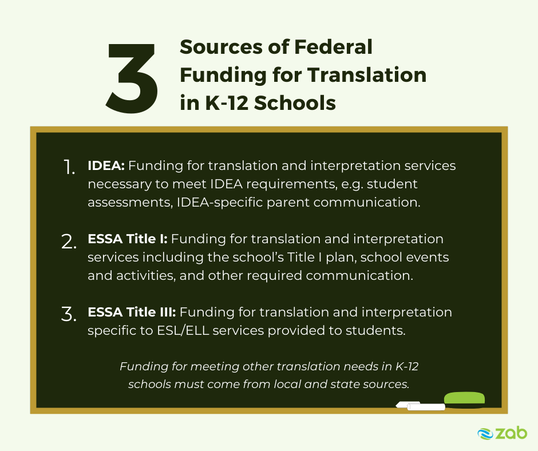A language barrier.
Translation allows you to overcome that challenge, so the next thing to address is how to pay for it. Many districts aren’t aware that there is federal funding available to supplement state and local funding for translation in schools. We’ll cover the basics of federal funding under the Individuals with Disabilities Education Act (IDEA) and the Every Student Succeeds Act (ESSA) Title I, Part A and Title III, Part A.
Translation Obligations and Funding
Schools are required to make information shared with parents accessible regardless of proficiency in English. They also may not charge parents for translation. Local and state public school funding are the primary resources for covering the costs of translation services. Ask your principal about how state and local school funding is allocated for translation at your school.Supplemental federal funding is available to cover certain translation costs under IDEA, ESSA Title I, Part A, and ESSA Title III, Part A. While these laws cover educational needs more broadly, we’ll review what these programs require and cover specifically for translation below.
IDEA
IDEA ensures that students with disabilities have access to a free public education and receive any additional educational services they need. When it comes to conducting student assessments and communicating with parents who are not proficient in English, translation services are necessary.IDEA funding may be used to pay for translation services that meet its requirements, including
- • student assessments,
- • notices about identification, evaluation, and educational placement of student,
- • requests for consent for educational services, and
- • notification of right to confidentiality.
ESSA Title I, Part A
Generally speaking, Title I funds can be used to fill Title I-specific requirements, including- • achievement information,
- • report cards of state and local educational agencies,
- • Parents’ Right to Know,
- • school’s Title I plan,
- • school and parent programs, meetings, activities and planning for those events,
- • Parent and Family Engagement policy,
- • School Improvement identification and all necessary details and rights related to that identification, and
- • information about student identification as an English Learner and details about instruction programs.
Schools using Title I funding fall into two categories: Schoolwide Programs and Targeted Assistance Programs. Specific rules about funding use can vary based on which category your school falls into. Talk to your principal and district for more information about your school specifically.
Schoolwide Programs have at least 40 percent low-income student population. These schools can use Title I funds to benefit all students using a schoolwide plan based on a comprehensive needs assessment.
Targeted Assistance Programs offer supplementary education services to students selected to participate in Title I. These schools must use scientifically-based research.
ESSA Title III, Part A
You can use Title III funds to pay for translations of any required notices and communication to parents and guardians in Title III. This communication centers on student identification and placement in a language instruction program. You’ll need to provide details about the program, other program options available, how the student specifically will benefit, and information on how parents can be involved. If applicable, you’ll also need to notify parents of failure to meet the Title III Annual Measurable Achievement Objectives (AMAOs).Local Educational Agencies (LEAs) and State Educational Agencies (SEAs) can use Title III funds to contract with a translation company to provide these notices. LEAs can also use Title III funds to cover supplemental translation and interpretation services that are specific to Title III services and students.
In other words, Title III funding cannot be used for translation required by other laws or regulatory entities, like the Department of Education Office for Civil Rights (OCR), IDEA, and Title I.
It may be that your school district has a contract with a translation company to do all of the translation work you need. The funding you use to pay for these services will change based on what regulatory requirement the document fills.
Understanding funding guidelines and availability will help you get the translation services you need to connect with parents and ensure your students have the support they need.
Need help with translation at your school? Get a quick quote or email [email protected] to ask for service and pricing details.



 RSS Feed
RSS Feed